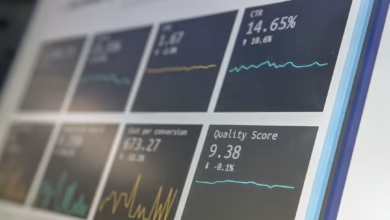Mastering ETF Trading: A Comprehensive Guide to Strategies, Risk Management, and Market Analysis

In the ever-evolving landscape of financial markets, ETF trading has emerged as a powerful tool for investors seeking exposure to diversified portfolios without the complexities of traditional stock trading. Exchange-traded funds, or ETFs, provide an efficient way to track indices or specific sectors, making them an attractive option for both novice and experienced traders. As the popularity of online trading platforms continues to rise, understanding the intricacies of ETF trading becomes essential for those looking to enhance their investment strategies.
This article offers a comprehensive guide to ETF trading, delving into various strategies tailored for index and sector-focused approaches. We will explore key trading strategies, from swing trading and day trading to cutting-edge algorithmic trading techniques. Additionally, we will address the critical aspects of risk management and market analysis, equipping you with the tools necessary to navigate the complexities of ETF trading successfully. Whether you are interested in leveraging trading, futures trading, or even exploring the realm of crypto trading, mastering the fundamentals of ETF trading can open new avenues for investment growth and innovation. Join us as we dive deeper into this dynamic trading landscape and uncover the secrets to effective ETF trading.
- 1. Understanding ETF Trading: A Comprehensive Guide to Index and Sector Strategies
- 2. Key Trading Strategies for ETFs: From Swing Trading to Algorithmic Trading
- 3. Risk Management and Analysis in ETF Trading: Mastering Technical and Fundamental Approaches
1. Understanding ETF Trading: A Comprehensive Guide to Index and Sector Strategies
Understanding ETF Trading: A Comprehensive Guide to Index and Sector Strategies
Exchange-traded funds (ETFs) have become a popular choice among investors for their flexibility and the ability to diversify portfolios without the need to buy individual stocks. Understanding ETF trading is essential for anyone looking to leverage this investment vehicle effectively, whether you are engaging in stock trading, forex trading, or other forms of online trading.
ETFs track various indices or sectors, allowing traders to invest in a broader market exposure with the convenience of a single security. This makes them particularly appealing for day trading and swing trading strategies, where quick entry and exit points are crucial.
When trading ETFs, it is essential to employ sound trading strategies, including both technical analysis and fundamental analysis. Technical analysis focuses on price patterns and trading volume, which can help traders make informed decisions on when to buy or sell. On the other hand, fundamental analysis involves evaluating the underlying assets of an ETF, such as the health of the companies comprising the index or sector, which can influence price movements over the long term.
For those interested in index trading, ETFs provide an easy way to gain exposure to major market indices like the S&P 500 or the NASDAQ. Additionally, sector ETFs allow traders to focus on specific industries, such as energy trading or technology, making it easier to capitalize on sector-specific trends.
Risk management is another critical aspect of ETF trading. Utilizing strategies such as leverage trading and margin trading can amplify potential gains, but also increases risk. Traders must carefully assess their risk tolerance and consider using stop-loss orders to manage potential losses.
Moreover, with the rise of algorithmic trading and high-frequency trading, many traders are now employing sophisticated tools and algorithms to execute trades rapidly and efficiently. These technologies can enhance trading strategies, allowing for real-time market analysis and the ability to capitalize on price discrepancies through arbitrage trading.
For those who prefer a more hands-off approach, copy trading and social trading platforms enable investors to follow and replicate the trades of successful traders. This can be particularly beneficial for beginners who are still developing their trading psychology and looking to learn from experienced market participants.
In summary, ETF trading offers a versatile and efficient way to engage with the markets. By understanding the various strategies involved, including derivatives trading, CFD trading, and options trading, traders can better navigate the complexities of index and sector strategies. Whether you are a seasoned trader or just starting, mastering these concepts is essential for success in the dynamic world of trading.
References
– BlackRock. (2023). What are ETFs? Retrieved from https://www.blackrock.com/us/individual/etf
– Investopedia. (2023). Exchange-Traded Fund (ETF). Retrieved from https://www.investopedia.com/terms/e/etf.asp
– Morningstar. (2023). Understanding ETF Investing. Retrieved from https://www.morningstar.com/etfs/understanding-etfs
2. Key Trading Strategies for ETFs: From Swing Trading to Algorithmic Trading
When it comes to ETF trading, adopting the right trading strategies can significantly enhance your potential for success. Here, we’ll explore key strategies ranging from swing trading to algorithmic trading, each catering to different trading styles and risk appetites.
Swing Trading: This strategy involves holding ETFs for several days or weeks to capitalize on expected upward or downward market movements. Swing traders often utilize technical analysis to identify entry and exit points, focusing on price patterns and volume trends. By analyzing market sentiment and news events, swing traders can make informed decisions about their trades. This approach is ideal for those who prefer to avoid the stress of day trading while still seeking to profit from short-term market fluctuations.
Day Trading: For those looking to capitalize on minute-by-minute market changes, day trading offers the opportunity to buy and sell ETFs within the same trading day. This strategy requires a keen understanding of market analysis, including technical indicators and trading psychology, to manage the rapid pace of trades. Day traders must be prepared to react quickly to market movements and often employ risk management techniques to protect their capital.
Algorithmic Trading: As technology advances, algorithmic trading has gained traction among ETF traders. This strategy uses computer algorithms to automate trading based on predefined criteria. Algorithmic trading can execute trades at high speeds, making it suitable for high-frequency trading strategies or arbitrage trading opportunities. Traders can customize algorithms to incorporate various factors, including technical and fundamental analysis, thereby enhancing their trading efficiency and effectiveness.
Scalping: This is a high-frequency trading strategy where traders aim to make small profits from numerous trades throughout the day. Scalpers often focus on liquid ETFs and utilize margin trading to amplify their returns. This strategy demands intense concentration and quick decision-making skills, making it suitable for traders who thrive in fast-paced environments.
Copy Trading and Social Trading: For beginners, copy trading and social trading platforms allow traders to mimic the trades of more experienced traders. This can be a valuable way to learn about ETF trading strategies while potentially profiting from the expertise of others. These platforms often provide insights into the trading decisions of successful traders, which can enhance your own market analysis skills.
Incorporating effective risk management into any of these trading strategies is crucial. Traders must be aware of the potential risks associated with leverage trading, derivatives trading, and other forms of trading that can amplify losses. Developing a solid trading plan, combined with disciplined execution and ongoing market analysis, will contribute to long-term success in ETF trading.
By understanding and implementing these key trading strategies—swing trading, day trading, algorithmic trading, and more—traders can navigate the complexities of the market while optimizing their ETF trading performance.
References:
– O'Connor, T. (2022). Trading Strategies for Successful ETF Investing. Retrieved from [link].
– Smith, J. (2023). Understanding Algorithmic Trading: A Beginner's Guide. Retrieved from [link].
– Johnson, R. (2023). The Psychology of Trading: Managing Emotions in the Market. Retrieved from [link].
3. Risk Management and Analysis in ETF Trading: Mastering Technical and Fundamental Approaches
Risk management and analysis are crucial components of successful ETF trading, particularly when navigating the complexities of financial markets. By honing both technical and fundamental approaches, traders can better manage risks and enhance their trading strategies.
Technical analysis involves evaluating price movements and market trends using charts and indicators. Traders can identify patterns that suggest potential future movements in ETF prices, allowing for informed decisions in index trading or sector-focused strategies. Key tools include moving averages, Relative Strength Index (RSI), and Fibonacci retracement levels. These technical indicators can help traders develop effective trading strategies, whether they are engaging in day trading, swing trading, or even high-frequency trading.
On the other hand, fundamental analysis focuses on the underlying factors that affect the value of ETFs. This includes examining economic indicators, sector performance, and market sentiment. For instance, understanding macroeconomic trends can provide insights into energy trading or commodities trading, helping traders anticipate market shifts. Additionally, keeping an eye on company earnings reports and geopolitical events can aid in making informed decisions in the broader context of stock trading and forex trading.
Effective risk management is essential in ETF trading, particularly when utilizing leverage trading or margin trading strategies. Traders must set stop-loss orders to protect their investments and avoid significant losses during market volatility. Furthermore, applying position sizing techniques can help to mitigate risks associated with derivatives trading and options trading, ensuring that no single trade disproportionately affects a trader's overall portfolio.
Incorporating trading psychology into both technical and fundamental analysis is another vital aspect of risk management. Traders must remain disciplined and avoid emotional decision-making, as this can lead to poor outcomes in online trading platforms or when implementing strategies like copy trading and social trading. By developing a robust trading plan that includes clear entry and exit points, traders can maintain a rational approach even in the face of market uncertainties.
Ultimately, mastering risk management and analysis in ETF trading requires a blend of technical and fundamental strategies. By effectively utilizing these approaches, traders can enhance their market analysis, make informed decisions, and navigate the complexities of various trading environments, from scalping and arbitrage trading to binary options and crypto trading.
With a solid understanding of these elements, traders can position themselves for success in the ever-evolving landscape of financial markets.
In conclusion, ETF trading presents an accessible entry point for both novice and experienced traders looking to diversify their portfolios through index and sector strategies. By understanding the intricacies of ETF trading, including the various trading strategies such as swing trading, day trading, and algorithmic trading, traders can effectively navigate the complexities of the financial markets.
Moreover, implementing robust risk management techniques and mastering both technical and fundamental analysis are crucial for long-term success in this dynamic environment. As the landscape of online trading continues to evolve, employing strategies like high-frequency trading, copy trading, and even arbitrage trading can enhance your trading approach.
Ultimately, whether you are venturing into stock trading, forex trading, or exploring the realms of commodities trading and crypto trading, the principles of ETF trading remain relevant across all markets. As you embark on your trading journey, remember that maintaining a strong trading psychology and understanding market analysis will set you apart in the competitive world of trading. Embrace the opportunities that ETF trading offers, and stay informed to adapt to the ever-changing market conditions.
References:
[Include your references here]




